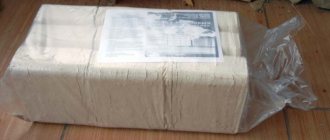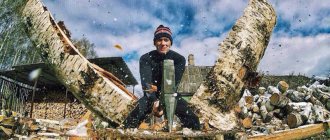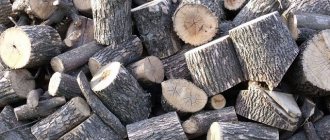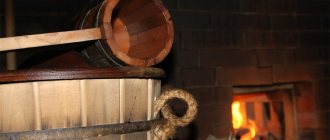Wood splitting options
You need to understand the difference between the processes of splitting and chopping wood. Splitting is dividing a log or block of wood into large fragments using a cleaver. To chop is to divide into smaller parts, cut off branches, cut down thin trees. They usually chop thin logs and divide them with an ax into chips and a splinter.
There are only two options for splitting firewood, either with the use of special equipment or without it.
Mechanical method
This method involves the use of equipment. The best option is an electric conical screw cleaver. On the tabletop there is a rotating steel cone with a thread, which splits the block of wood brought to it. A hydraulic cleaver works on the same principle, but the splitting occurs under the influence of a jack.
Both devices are quite dangerous to use. Without experience, it is better not to use it and first learn how to work with the mechanism.
Manual method
This method involves chopping wood with a cleaver or an ax on a prepared deck.
Rules for working with the Kolundrov wood splitter:
1. Place the log splitter on a hard, level surface. For best results, secure it with wood screws through the holes in the sole. 2. Place the wooden log on the edge of the knife, inside the upper ring of the wood splitter, resting it on the ring. If the log is significantly smaller in diameter than the splitter ring, move the log toward one of the posts. 3. Using a sledgehammer, hit the log until it completely splits into two parts. For safety reasons, it is recommended to stand on the side of one of the support posts of the wood splitter. 4. After splitting, remove the log pieces from the log splitter. To split into smaller fragments, repeat the procedure until the desired result is achieved. 5. Be careful when splitting firewood or boards that have been used previously on the farm; they contain nails that can damage the splitting knife. 6. Also, to avoid damage and jamming of the knife edge, it is not recommended to place the log directly with the knot on the edge of the wood splitter knife. Place the log so that the knot does not touch the edge of the knife or the side of the log that does not have obvious large knots. 7. For the best result, the weight of the sledgehammer should be selected individually for the type of wood, knotiness and size of the logs. The average option is a sledgehammer weighing 1.5 kg; for large and very knotty logs you should use a sledgehammer weighing 3-4 kg.
8. If a “spring effect” is noticed when chopping firewood, this means that the wood splitter is installed on an unsuitable (not hard enough) or uneven surface. 9. Keep the tool clean, periodically clean it from dust and dirt. Store the log splitter in a dry place. To avoid the formation of corrosion, before long-term storage, it is recommended to lubricate the edge of the wood splitter knife with a thin layer of oil or grease.
Owners of fireplaces, stoves, barbecues, grills or barbecues will appreciate the work of simple and reliable Kolundrov wood splitters as a quick and safe way to chop firewood, splinters or wood chips for ignition in a couple of minutes. It really works, see for yourself!
What is needed to split wood?
To properly chop wood you need to have the appropriate tool.
- Deck.
This is a thick cut of wood installed vertically. The deck must be at least half a meter high and have a sufficiently large diameter. The knottier the deck, the stronger it will be. Outside you need to leave a couple of knots that will serve as handles for dragging.
The stump for the deck is best taken from oak or elm. If there are none, you can use thick birch, but such a deck will last less.
Oak decks last about 8 years. To prevent the deck itself from splitting from impacts, it is reinforced with a metal strip or chain.
- Ax or cleaver
An ax with a sharp blade is needed for chopping thin logs, removing knots, and preparing wood chips. There are different types of cleavers. A heavy cleaver with a blunt blade wedges thick logs, dividing them into parts. Lightweight cleavers have a blade shape in the form of a sharpened wedge or a classic one.
The cleaver must be selected correctly. Of course, the handle should be comfortable and fit the width of your palm. The weight is also selected “to suit you”, taking into account the fact that you will have to swing. The handle should be birch, the hand fits well on it. Plastic or metal slides. There are rubberized handles, they are comfortable, but they are usually found on expensive instruments.
- Wedges.
Can be useful for splitting hard, thick tree cuts. It is used in addition to the cleaver used to pierce the log. A wedge is inserted into the crack formed. Hammered with a sledgehammer to split the log. Wedges can be smooth or jagged.
Choosing a tool: an ax or a cleaver
You need to chop wood with a special tool. An ax and a cleaver are used in the work. Externally, these two instruments are similar. But they differ in size, weight and application. The right thing to do is to use both tools in your work, but for different logs and different wood.
Axe
An ax is a percussion chopping hand tool that weighs about 1 kg or less. Has a sharp metal blade. Used for raw wood, branches, knots.
Cleaver
The appearance of the cleaver is similar to an axe. But there are characteristic differences. A cleaver is a heavier tool. Its weight is almost twice the weight of the ax and is 2 kg or more. He's massive and dumb.
The handle of a cleaver is usually longer than the handle of an axe. The metal part, the blade, is not sharpened sharply. The sharpening angle of the cleaver is about 40-60°. The chopping part of the tool remains dull.
Thanks to this design, the heavy cleaver will not “get stuck” in the wood and will split the log into pieces well.
The cleaver is used for splitting heavy large logs, dense wood, and large logs of large diameter.
Which cleaver is easier to chop wood with - a heavy blade or a lightweight one? Choose a tool for yourself. It should optimally combine the characteristics of weight and your physical strength. You will not be able to lift and lower a cleaver that is too heavy within two hours of work.
What else is important? The metal sheet must be forged. On sale there are cleavers with cast metal. Cast - may crack. Forged fabric rarely cracks.
Both the cleaver and the ax can have a wooden or fiberglass handle. What should a beginner choose? Choose fiberglass. This material fits quite tightly in the hand. Doesn't slip. And most importantly, it prevents the metal ax from “flying” off the shaft. But the ax handle sometimes falls off the wooden handle.
Preparatory stage of cutting wood
The preparatory stage involves sawing trees manually or mechanized. It's better to use a chainsaw. You can saw by hand, then you need sawhorses into which the log is placed. It's faster to work together, but you can do it alone.
The cut tree is split into logs, which must be 20% shorter in height than the length of the fuel compartment of the boiler or stove. You don't have to remove the bark for now. Knots are separated with the same saw or ax.
Preparatory stage
It is recommended to dry the wood, that is, do not split it immediately. It is not easy to cut down fresh wood; the tool gets stuck in the damp wood. If the work is carried out in winter, you need to let the logs freeze well, then it will be easier to chop them.
Then the equipment and area for work are prepared. The deck is placed on a flat area not far from the sawn logs and work begins.
Equipment
When cutting wood, the right equipment is just as important as the tools.
To work, you need to prepare protective accessories:
- Gloves. They should fit your hand well and not slip on the handle. It’s better to take fabric ones with a rubberized palm or old leather ones. It is not recommended to use mittens, as they may fall off the hand. If the ax handle slips out along with the mitten, this could end sadly.
- Safety glasses, half mask. The glass must be clean (not scratched or dirty), this will reduce the accuracy of the strike.
- Comfortable shoes or boots.
- Clothing can be anything, but not unbuttoned or very wide. Nothing should accidentally get under the ax or interfere with the force of the swing.
Wood splitting technique
Following the technique of chopping wood manually and mechanically will allow you to work without unnecessary labor costs.
Manually
Large logs are chopped with a cleaver. It has a dull blade that splits.
How to chop wood with a cleaver:
- Place the block of wood on the deck, moving it to the opposite edge of the base.
- Select the largest crack in the cut and hit it with a cleaver.
- For a smooth cut, choose a place to strike without knots.
- If the cleaver gets stuck, you need to hit the butt with a sledgehammer or drive a wedge nearby.
- Continue to divide the split log into smaller parts.
- If the wood cut is too thick, it is better to start splitting from the edges, reducing its diameter.
How to chop wood with an ax:
- You can chop logs of small diameter by placing them vertically on a log.
- The log, divided in half, is again placed vertically and split into quarters with a precise blow of an ax.
- The bark is removed from the logs with an axe. The bark can be cut into small strips and used for ignition.
- You can continue to chop the log into chips. Wood chips are also good for ignition.
When chopping wood, your feet should be shoulder-width apart.
When chopping wood, technique is important. How to chop wood correctly:
- Feet should be shoulder-width apart. This is important for better support and safety. If the ax gets out of your hands, it won't hit your leg.
- Stand at arm's length from the deck. The ax's end should touch the edge of the deck.
- With both hands, firmly grasp the handle of the tool and lift it to a sufficient height. There is no need to raise the tool high, otherwise the impact force will decrease.
- The blow must be sharp, you must use your own gravity and the force of the cleaver.
Mechanically
The steps are very simple. Place the deck on the platform of the screw cleaver close to the cone. Turn on the unit. Holding the block of wood from above, move it onto the cone, which will screw into the tree and split it. Repeat the operation, turning the log 90 degrees.
Mechanical method of chopping wood
When using a hydraulic jack, the block of wood is brought under the cutting part. The split log is put there again and so on until the desired size.
How to chop wood without an axe: several options
If you are somewhere far away in nature or went to the country, but forgot your ax with you, don’t worry, you won’t be left without heating, because you can split logs without an axe. There are several ways to do this.
Option 1: pebbles + sledgehammer . We need to take a granite pointed pebble (there are plenty of such objects near the river, near roads, even in plantings) or any other hard mineral and place its sharpest end to the log. To keep it in place, you need to take some dirt, put it on a log and stick a stone there (this way it won’t fall). Then you need to take a larger sledgehammer and apply the O.S. method. Ipatova - hit the stone hard. The log will definitely split, since we will have a cleaving effect.
Option 2: hammer drill + shovel. Why not? Another method of chopping wood without an axe. With the help of a hammer drill, you can not only anger your neighbors in your apartment, but also chop wood efficiently and evenly. We take the largest blade attachment and actively drive it into the log. Or use a cone attachment. The advantage of the method is the speed and accuracy of wood cutting.
Option 3: drill + cone . This wood splitting technique is a little slow, but still works, especially with hardwoods. If you have a drill and an attachment in the form of a construction cone on your farm (they are often homemade), then you can try using it to chop small logs (only small ones!). For objects with substantial dimensions, they use a standard 380V motor with a cone, about 2-3 kW of power and low speed.
This is how you split wood with your own hands without an ax and with an axe, and now in the video we’ll look at one of the best ways to do it correctly and quickly with a cleaver:
How to chop wood quickly and easily?
There is a little trick that allows you to chop wood quickly and easily. With regular chopping, the logs scatter far from the deck. You have to spend energy collecting them and installing them again on the deck. The chopping process is already very difficult for your back, and you still have to spend effort bending.
You need to take a tire, attach it to a block and install a block of wood in it. If there is a metal cord on the tire, it must be removed. If it accidentally slips, the cleaver may become jagged. When a block of wood in a tire splits, the cut will not fly off and you can continue dividing it into small parts.
Security measures
Any operations with piercing and cutting tools must be carried out in compliance with appropriate safety measures:
- Strengthen the ax the day before chopping. Place it in a bucket of water, the ax handle will swell, and the cleaver will sit firmly. It is better, of course, to keep it in water for several days. This measure is only applicable for tools with a wooden handle. If the handle is made of metal or plastic, then the operation is useless. You will have to check the strength of the structure manually.
- If an ax is used, it must be well sharpened. It is necessary to sharpen the ax before each felling.
- Make sure that there is no one within a radius of three meters from the deck. Also, do not chop wood close to the windows, as logs may fly there. An inexperienced woodcutter can leave more empty space around.
- Do not try to split along the knot; the cleaver may either fly off or get stuck tightly.
- Do not wear mittens; they may slip off your hand or change the force of the blow. This poses a risk of injury. Only gloves can be worn.
- When using mechanization tools, keep your hands as far as possible from the cutting tool.
After cutting, you need to put the firewood in a woodpile, leaving air space between them. It is better to stack the woodpile after finishing the entire cutting process. Gradually, the work of chopping wood will become familiar and the speed will increase significantly.
How to chop wood correctly?
Smart home 3
0
Chopping wood requires not only strength, but also skill. Where an expert would effectively split a log with a dashing blow, a beginner will sweat for a long time. The secret is not a secret at all - you need to prepare a place, a tool and spend a little time on practice to master the splitting technique. We tell you how to save time and effort when preparing firewood.
Don't clutter your workspace!
There must be enough free space on the site intended for chopping wood. Firstly, swinging an ax requires space, and secondly, splinters regularly fly off from split logs. If you work under a shed or in a shed, then pay attention to the height of the ceiling - it should exceed an outstretched arm with an ax.
The logs are placed on a block, which is a strong and thick piece of log. The more knots, the better - they, like bolts, increase the strength of the deck. The deck must stand on a hard surface - either trampled earth or concrete.
Take the tool
There are two types of tools for preparing firewood: a heavy cleaver-sledgehammer and its lighter variations with a narrow blade, complemented by protrusions for splitting. The cleaver is equipped with a blunt blade and splits the log like a wedge due to its gravity; the blow requires effort to swing. Lightweight versions of the cleaver split wood and require less effort, but they are not suitable for large logs.
The length and material of the ax depends on personal preference. The cleaver should lie confidently in your hand, and your fingers should tightly clasp the handle. It is recommended to have both types of axes on hand for chopping wood and alternate them so as not to exert unnecessary effort.
Remember safety precautions!
Chopping wood, like any physical labor using tools, is associated with danger. To avoid injury, prepare protective equipment:
- gloves that do not slip on the ax handle;
- plastic glasses to protect your eyes from splinters;
- strong boots.
Note: the day before, place the ax with a wooden hatchet in a bucket of water so that the blade is submerged with a small margin. The wood will swell and firmly hold the cutting surface.
Before starting work, be sure to inspect the axe: the ax handle must be intact, without cracks, the metal blade must sit securely on the ax handle.
Less movement, more precision
When the logs are dried or slightly frozen, they are easier to split, so plan your firewood preparation in advance. Remember that it is easier to dry fresh wood than to chop it.
The log is located on the log with the knots down, most logs have cracks, find one and turn it towards you - this is your target. If the log is whole, then aim the cleaver between the knots.
The correct position for striking is with your feet shoulder-width apart for balance. Do not rush to waste energy on a wide swing - it is more effective to lower sharply, using the weight of the tool.
If the first blow fails to split the log, then pull out the ax and shake it up and down. If the blade is stuck tightly, drive it in with a sledgehammer like a wedge. A small log with a stuck ax blade is lifted and, turned upside down, hit against the log.











